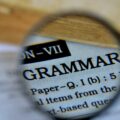Which Sentence Correctly Uses Parallel Structure
You’re probably wondering, “which sentence correctly uses parallel structure?” Well, you’ve come to the right place! I’m about to delve into the fascinating world of parallelism in sentences. This grammatical concept is vital for clear and effective communication. Without it, our writing can become clunky and confusing.
Parallel structure (or parallelism) refers to using elements that are grammatically similar or identical in structure within a sentence. It ensures consistency and clarity in your writing – qualities we all aim for! For a sentence to be considered ‘parallel’, it must balance its use of verbs, nouns, phrases or clauses correctly. It’s like walking a linguistic tightrope!
Check out our next post for more amazing content!
What does this look like in practice? Let’s dive deeper into understanding which sentence correctly uses parallel structure, how you can spot mistakes, and most importantly – how you can fix them!
Understanding Parallel Structure
Let’s talk about parallel structure. It’s a concept in grammar that makes our sentences clear, concise, and easy to understand. Simply put, parallel structure means using the same pattern of words or phrases within a sentence. This ensures that all parts of your sentence match in terms of form.
Wondering what this looks like? Let’s dive into some examples:
- “I love hiking, biking, and swimming.” In this case, ‘hiking’, ‘biking’, and ‘swimming’ are all gerunds (verbs acting as nouns), making the structure parallel.
- Incorrect: “He likes reading novels and to play chess.” Correct: “He likes reading novels and playing chess.”
The incorrect sentence doesn’t follow the rule of parallelism because it uses two different forms—’reading’ (gerund) and ‘to play’ (infinitive). To correct it, we must make sure both activities are expressed in the same way—either both as gerunds or both as infinitives.

Identifying Correct Use of Parallel Structure
Unraveling the secret of which sentence correctly uses parallel structure can feel like a tough task. But trust me, it’s easier than it seems.
First off, let’s get a basic understanding of what parallel structure is. It’s a style choice in writing that involves using the same pattern of words or phrases to show that two or more ideas have equal importance. This could be anything from items in a list to parts of a sentence.
A good example would be: “I love hiking, swimming, and cycling.” Here, all the activities are listed in their base form – hiking, swimming, cycling – keeping things consistent (or parallel).
Now how do we identify when this structure is used correctly?
Here are some tips to help you out:
- Look for lists: In sentences with multiple items or actions listed out (like my earlier example), check if they’re all presented in the same form.
- Check for conjunctions: Words like ‘and’, ‘or’ & ‘but’ often denote parallel structures. The elements before and after these conjunctions should ideally be similar.
- Spot comparisons: Sentences making comparisons also often use parallel structures.
Let’s take an example: “John likes reading more than he likes to swim.” This sentence doesn’t maintain parallelism because ‘reading’ isn’t in the same form as ‘to swim’. A better version would be: “John likes reading more than swimming.”
So there you go! Identifying whether a sentence correctly uses parallel structure isn’t such an enigma anymore, right? Keep these pointers in mind next time you’re questioning if a sentence has got its parallels right!
My name is Andrea Thompson and I’m a home based freelance writer. I’m 23 years old, married to my best friend, and mother to a wonderfully independent and opinionated 3 year old girl and step-mother to a sweet seven year old boy. I live in a tiny, little town in Kentucky, where I spend my free time fishing with my kids.
Writing has always been my passion, which I followed through high school, and for a while in college. Life happened, and once I discovered we were pregnant, I switched directions; opting for the healthcare industry because of the stability.
Finally, years later, I was in a place where I could leave the day job that never truly made me happy, and pursue my dreams. I’ve built, and am still building, my writing career from scratch. But, I’m passionate and I’m good at what I do. And, in the end, I can prove to my daughter that she can do anything she wants with this life.





